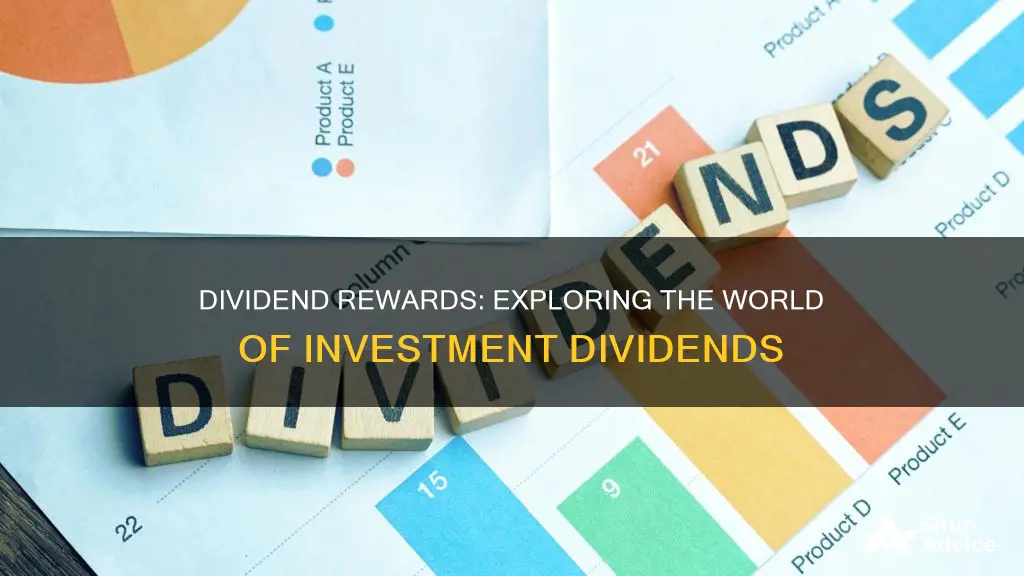
Dividends are a way for companies to distribute their earnings to shareholders. They are not mandatory, but they are a common practice for profitable companies. Dividends can be paid out in cash or stock, and they are typically done on a quarterly basis. The amount of dividend paid out is calculated on a per-share basis. For tax purposes, dividends are classified as either qualified or unqualified, depending on how long the shareholder has held the stock. Dividend-paying companies tend to be well-established and large-cap, as they do not need to reinvest their earnings back into the business.
| Characteristics | Values |
|---|---|
| Definition | A dividend is a payment in cash or stock that public companies distribute to their shareholders. |
| Types | Cash dividends, stock dividends, special dividends |
| Who Pays Dividends | Publicly traded companies, mutual funds, exchange-traded funds (ETFs), private companies |
| Who Receives Dividends | Shareholders, stockholders, investors |
| Payment Frequency | Monthly, quarterly, yearly, irregular |
| Dividend Yield | Calculated by dividing the stock's annual dividend amount by its current share price |
| Taxation | Qualified dividends and ordinary dividends are taxed differently |
| Reinvestment | Dividend reinvestment plans (DRIPs) allow investors to use dividends to purchase additional stock |
What You'll Learn

Dividend-paying stocks
When investing in dividend-paying stocks, it is important to consider the company's financial health and stability. Larger, established companies with predictable profits are often the best dividend payers. Additionally, companies in certain industry sectors, such as healthcare, pharmaceuticals, and consumer staples, tend to have a regular record of dividend payments.
It is also crucial to understand the tax implications of dividend income. Dividends are generally taxable, and the tax rates depend on the type of account you hold the stocks in and the length of time you have held the stocks. Qualified dividends, where you have owned the stocks for a certain minimum period, are typically taxed at lower capital gains rates, while unqualified dividends are taxed as ordinary income.
When investing in dividend-paying stocks, you can choose between individual companies and dividend-focused funds or ETFs. Individual companies allow you to focus on a few specific companies that you know well, while funds or ETFs provide diversification across a larger number of companies.
Some examples of dividend-paying stocks include:
- Verizon Communications Inc. (VZ)
- Stellantis NV (STLA)
- Gilead Sciences Inc. (GILD)
- Realty Income Corp. (O)
- National Storage Affiliates Trust (NSA)
- British American Tobacco PLC (BTI)
- Molson Coors Beverage Co. (TAP)
In summary, dividend-paying stocks offer investors a stable and consistent income stream, making them a great option for long-term investment portfolios. By choosing established companies with strong financial health and considering the tax implications, you can maximize the benefits of dividend-paying stocks.
Smart Ways to Invest $500 Today
You may want to see also

Dividend yield
For example, consider two companies that pay $1 per share as a dividend. If the first company's stock price is $30 and the second company's stock price is $20, the first company's dividend yield is 3.3%, while the second company's dividend yield is 5%. Thus, the second company appears to be a better investment option as it offers a higher return of 5%.
However, it is important to note that a company's dividend yield can change over time as its stock price fluctuates. Additionally, a high dividend yield may not always indicate a good investment opportunity, as it could be the result of a declining stock price. Therefore, investors should also consider other factors, such as the company's financial health and stability, when making investment decisions.
Dividend-focused mutual funds and ETFs, such as the Vanguard High Dividend Yield ETF (VYM), offer a diversified approach to investing in dividend-paying companies. These funds tend to hold companies with higher dividend yields than average, providing investors with the potential for higher income.
Lucrative Investment Opportunities: Exploring Avenues with 10 Percent Returns
You may want to see also

Dividend growth
A company's dividend growth rate can be calculated in a few ways:
- Using historical dividend growth rates to calculate the arithmetic average or compound annual growth rate (CAGR).
- Observing the dividend growth rate prevalent in the industry in which the company operates.
- Calculating the sustainable growth rate, which is the maximum growth rate a company can sustain without external financing.
When investing in dividend stocks, it is important to consider both the dividend yield and dividend growth. Dividend yield is the amount that a company pays out in dividends compared to its stock price, while dividend growth reflects the increase in dividend value over time.
Smart Places to Invest $2K Right Now
You may want to see also

Dividend reinvestment plans
DRIPs are typically offered by publicly traded companies to existing shareholders, but some companies also make them available to new investors. They allow investors to buy shares commission-free or for a nominal fee, and sometimes at a significant discount to the current share price.
There are two main types of DRIPs: brokerage account plans and company DRIPs. With brokerage account plans, investors can access multiple investment types—such as individual stocks, mutual funds, and ETFs—from the convenience of one account. This makes it easier to diversify holdings, either by investing in many dividend stocks or by choosing a mutual fund that invests in many companies on behalf of the investor.
Company DRIPs, on the other hand, are solely for people who want to invest in individual stocks and one specific stock at that. This limits the ability to invest in other options available through brokerage accounts, like mutual funds or exchange-traded funds. Some companies also require investors to be existing shareholders to enroll in a DRIP.
It's important to note that dividends paid into DRIPs are taxed, even though they are used to purchase shares. Investors should also be aware that they may have to pay taxes on reinvested dividends from their own funds.
Pay Off Auto Loans or Invest: The Smart Choice for Your Money
You may want to see also

Dividend taxation
Dividends are a portion of a company's earnings that are paid directly to shareholders. They are taxed differently depending on whether they are qualified or unqualified dividends.
Qualified Dividends
Qualified dividends are taxed at the same rates as the capital gains tax rate, which is lower than ordinary income tax rates. For the 2023 tax year, qualified dividends may be taxed at 0% if your taxable income falls below:
- $44,625 for those filing single or married filing separately
- $59,750 for head of household filers
- $89,250 for married filing jointly or qualifying widow(er) filing status
The qualified dividend tax rate increases to 15% for taxable income above:
- $44,626 through $276,925 for married filing separately filers
- $44,626 through $492,300 for single filers
- $59,751 through $523,050 for head of household filers
- $89,251 through $553,850 for married filing jointly or qualifying widow(er) filers
Qualified dividend income above the upper limits of the 15% bracket requires paying a 20% tax rate on any remaining qualified dividend income. Depending on your specific tax situation, qualified dividends may also be subject to the 3.8% Net Investment Income Tax.
Unqualified or Ordinary Dividends
Ordinary dividends are taxed at the same rates as standard federal income tax rates, which for the 2023 and 2024 tax years are 10% to 37%.
How to Minimise Taxes on Dividends
One way to minimise taxes on dividends is to try to have qualified dividends, which incur a lower tax rate than unqualified dividends. Another method is to open a tax-advantaged brokerage account, such as an IRA, where you can defer taxes until you withdraw from the account and are in a lower income tax bracket.
Doge Investment: How to Buy Now
You may want to see also
Frequently asked questions
Dividends are how companies distribute their earnings to shareholders. Dividends can be cash, additional shares of stock, or warrants to buy more stock.
Dividends may be paid on a monthly, quarterly, or yearly basis, depending on the company. Special dividends are paid on an irregular basis.
Dividend yield is a way to understand the relative value of a company's dividend payment. To calculate dividend yield, divide the stock's annual dividend amount by its current share price.
Dividends are taxed based on whether they are qualified or unqualified dividends. Qualified dividends are taxed at lower capital gains rates, while unqualified dividends are taxed as ordinary income.
A dividend reinvestment plan allows investors to use their dividend payments to purchase additional shares of stock, often at a discounted price.







